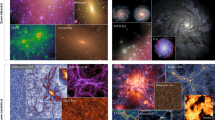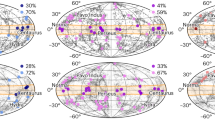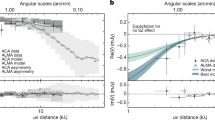Abstract
Cosmological simulations are crucial tools in studying the Universe, but they typically do not directly match real observed structures. Constrained cosmological simulations, on the other hand, are designed to match the observed distribution of galaxies. Here we present constrained simulations based on spectroscopic surveys at a redshift of z ≈ 2.3, corresponding to an epoch of nearly 11 Gyr ago. This allows us to ‘fast-forward’ the simulation to our present day and study the evolution of observed cosmic structures self-consistently. We confirm that several previously reported protoclusters will evolve into massive galaxy clusters by our present epoch, including the ‘Hyperion’ structure that we predict will collapse into a giant filamentary supercluster spanning 100 Mpc. We also discover previously unknown protoclusters with lower final masses than are typically detectable by other methods that nearly double the number of known protoclusters within this volume. Constrained simulations, applied to future high-redshift datasets, represent a unique opportunity for studying early structure formation and matching galaxy properties between high and low redshifts.
This is a preview of subscription content, access via your institution
Access options
Access Nature and 54 other Nature Portfolio journals
Get Nature+, our best-value online-access subscription
$29.99 / 30 days
cancel any time
Subscribe to this journal
Receive 12 digital issues and online access to articles
$119.00 per year
only $9.92 per issue
Buy this article
- Purchase on Springer Link
- Instant access to full article PDF
Prices may be subject to local taxes which are calculated during checkout




Similar content being viewed by others
Data availability
The data products generated for this study are available at https://zenodo.org/record/6425013.
Code availability
Analysis codes used for this study are available at https://github.com/gmetin/COSTCO.
References
Kravtsov, A. V. & Borgani, S. Formation of galaxy clusters. Annu. Rev. Astron. Astrophys. 50, 353–409 (2012).
Muldrew, S. I., Hatch, N. A. & Cooke, E. A. What are protoclusters? Defining high-redshift galaxy clusters and protoclusters. Mon. Not. R. Astron. Soc. 452, 2528–2539 (2015).
Miller, T. B. et al. A massive core for a cluster of galaxies at a redshift of 4.3. Nature 556, 469–472 (2018).
Oteo, I. et al. An extreme protocluster of luminous dusty starbursts in the early Universe. Astrophys. J. 856, 72 (2018).
Einasto, J. et al. Wavelet analysis of the cosmic web formation. Astron. Astrophys. 531, A75 (2011).
Suhhonenko, I. et al. The cosmic web for density perturbations of various scales. Astron. Astrophys. 531, A149 (2011).
Chiang, Y.-K., Overzier, R. & Gebhardt, K. Ancient light from young cosmic cities: physical and observational signatures of galaxy proto-clusters. Astrophys. J. 779, 127 (2013).
Overzier, R. A. The realm of the galaxy protoclusters. A review. Astron. Astrophys. Rev. 24, 14 (2016).
Chiang, Y.-K., Overzier, R. A., Gebhardt, K. & Henriques, B. Galaxy protoclusters as drivers of cosmic star formation history in the first 2 Gyr. Astrophys. J. Lett. 844, L23 (2017).
Capak, P. et al. The first release COSMOS optical and near-IR data and catalog. Astrophys. J. Suppl. Ser. 172, 99–116 (2007).
Lee, K.-G., Hennawi, J. F., White, M., Croft, R. A. C. & Ozbek, M. Observational requirements for Lyα forest tomographic mapping of large-scale structure at z ~ 2. Astrophys. J. 788, 49 (2014).
Lee, K.-G. et al. First data release of the COSMOS Lyα mapping and tomography observations: 3D Lyα forest tomography at 2.05 < z < 2.55. Astrophys. J. Suppl. Ser. 237, 31 (2018).
Newman, A. B. et al. LATIS: the Lyα tomography IMACS survey. Astrophys. J. 891, 147 (2020).
Horowitz, B. et al. Second data release of the COSMOS Lyman-α mapping and tomographic observation: the first 3D maps of the large-scale cosmic web at 2.05 < z < 2.55. Preprint at https://arxiv.org/abs/2109.09660 (2021).
Spitler, L. R. et al. First results from Z-FOURGE: discovery of a candidate cluster at z = 2.2 in COSMOS. Astrophys. J. Lett. 748, L21 (2012).
Yuan, T. et al. Keck/MOSFIRE spectroscopic confirmation of a Virgo-like cluster ancestor at z = 2.095. Astrophys. J. Lett. 795, L20 (2014).
Franck, J. R. & McGaugh, S. S. The Candidate Cluster and Protocluster Catalog (CCPC) II. Spectroscopically identified structures spanning 2 < z < 6.6. Astrophys. J. 833, 15 (2016).
Diener, C. et al. A protocluster at z = 2.45. Astrophys. J. 802, 31 (2015).
Lee, K.-G. et al. Shadow of a colossus: a z = 2.44 galaxy protocluster detected in 3D Lyα forest tomographic mapping of the COSMOS field. Astrophys. J. 817, 160 (2016).
Chiang, Y.-K. et al. Surveying galaxy proto-clusters in emission: a large-scale structure at z = 2.44 and the outlook for HETDEX. Astrophys. J. 808, 37 (2015).
Casey, C. M. et al. A massive, distant proto-cluster at z = 2.47 caught in a phase of rapid formation? Astrophys. J. Lett. 808, L33 (2015).
Wang, T. et al. Discovery of a galaxy cluster with a violently starbursting core at z = 2.506. Astrophys. J. 828, 56 (2016).
Cucciati, O. et al. The progeny of a cosmic titan: a massive multi-component proto-supercluster in formation at z = 2.45 in VUDS. Astron. Astrophys. 619, A49 (2018).
Darvish, B. et al. Spectroscopic confirmation of a Coma cluster progenitor at z ~ 2.2. Astrophys. J. 892, 8 (2020).
Polletta, M. et al. Spectroscopic observations of PHz G237.01+42.50: a galaxy protocluster at z = 2.16 in the COSMOS field. Astron. Astrophys. 654, A121 (2021).
Champagne, J. B. et al. Comprehensive gas characterization of a z = 2.5 protocluster: a cluster core caught in the beginning of virialization? Astrophys. J. 913, 110 (2021).
Cuesta, A. J., Prada, F., Klypin, A. & Moles, M. The virialized mass of dark matter haloes. Mon. Not. R. Astron. Soc. 389, 385–397 (2008).
Gottlöber, S., Hoffman, Y. & Yepes, G. Constrained local Universe simulations (CLUES). Preprint at arXiv https://doi.org/10.48550/arXiv.1005.2687 (2010).
Heß, S., Kitaura, F.-S. & Gottlöber, S. Simulating structure formation of the local Universe. Mon. Not. R. Astron. Soc. 435, 2065–2076 (2013).
Wang, H., Mo, H. J., Yang, X., Jing, Y. P. & Lin, W. P. ELUCID—exploring the local universe with the reconstructed initial density field. I. Hamiltonian Markov chain Monte Carlo method with particle mesh dynamics. Astrophys. J. 794, 94 (2014).
Jasche, J., Leclercq, F. & Wandelt, B. D. Past and present cosmic structure in the SDSS DR7 main sample. J. Cosmol. Astropart. Phys. 2015, 036 (2015).
Libeskind, N. I. et al. The HESTIA project: simulations of the Local Group. Mon. Not. R. Astron. Soc. 498, 2968–2983 (2020).
Ata, M. et al. BIRTH of the COSMOS field: primordial and evolved density reconstructions during cosmic high noon. Mon. Not. R. Astron. Soc. 500, 3194–3212 (2021).
Lilly, S. J. et al. zCOSMOS: a large VLT/VIMOS redshift survey covering 0 < z < 3 in the COSMOS field. Astrophys. J. Suppl. Ser. 172, 70–85 (2007).
Le Fèvre, O. et al. The VIMOS Ultra-Deep Survey: ~10,000 galaxies with spectroscopic redshifts to study galaxy assembly at early epochs 2 < z = 6. Astron. Astrophys. 576, A79 (2015).
Kriek, M. et al. The MOSFIRE Deep Evolution Field (MOSDEF) survey: rest-frame optical spectroscopy for ~1,500 H-selected galaxies at 1.37 < z < 3.8. Astrophys. J. Suppl. Ser. 218, 15 (2015).
Nanayakkara, T. et al. ZFIRE: a KECK/MOSFIRE spectroscopic survey of galaxies in rich environments at z ~ 2. Astrophys. J. 828, 21 (2016).
Ata, M., Kitaura, F.-S. & Müller, V. Bayesian inference of cosmic density fields from non-linear, scale-dependent, and stochastic biased tracers. Mon. Not. R. Astron. Soc. 446, 4250–4259 (2015).
Kitaura, F.-S. et al. COSMIC BIRTH: efficient Bayesian inference of the evolving cosmic web from galaxy surveys. Mon. Not. R. Astron. Soc. 502, 3456–3475 (2021).
Potter, D., Stadel, J. & Teyssier, R. PKDGRAV3: beyond trillion particle cosmological simulations for the next era of galaxy surveys. Comput. Astrophys. Cosmol. 4, 2 (2017).
Aragon-Calvo, M. A. The MIP ensemble simulation: local ensemble statistics in the cosmic web. Mon. Not. R. Astron. Soc. 455, 438–448 (2016).
Behroozi, P. S., Wechsler, R. H. & Wu, H.-Y. The ROCKSTAR phase-space temporal halo finder and the velocity offsets of cluster cores. Astrophys. J. 762, 109 (2013).
Planck Collaboration et al. Planck 2018 results. VI. Cosmological parameters. Astron. Astrophys. 641, A6 (2020).
Fontanelli, P. The Coma/A1367 filament of galaxies. Astron. Astrophys. 138, 85–92 (1984).
Einasto, M. et al. Sloan Great Wall as a complex of superclusters with collapsing cores. Astron. Astrophys. 595, A70 (2016).
Sugai, H. et al. Prime focus spectrograph for the Subaru telescope: massively multiplexed optical and near-infrared fiber spectrograph. J. Astron. Telesc. Instrum. Syst. 1, 035001 (2015).
Cirasuolo, M. et al. MOONS: the multi-object optical and near-infrared spectrograph for the VLT. In Society of Photo-Optical Instrumentation Engineers (SPIE) Conference Series Vol. 9147 (eds Ramsay, S. K. et al.) 91470N (2014).
Laigle, C. et al. The COSMOS2015 catalog: exploring the 1 < z < 6 Universe with half a million galaxies. Astrophys. J. Suppl. Ser. 224, 24 (2016).
Ilbert, O. et al. Mass assembly in quiescent and star-forming galaxies since z = 4 from UltraVISTA. Astron. Astrophys. 556, A55 (2013).
Brammer, G. B. et al. 3D-HST: a wide-field grism spectroscopic survey with the Hubble Space Telescope. Astrophys. J. Suppl. Ser. 200, 13 (2012).
Straatman, C. M. S. et al. The FourStar Galaxy Evolution Survey (ZFOURGE): ultraviolet to far-infrared catalogs, medium-bandwidth photometric redshifts with improved accuracy, stellar masses, and confirmation of quiescent galaxies to z ~ 3.5. Astrophys. J. 830, 51 (2016).
Crocce, M., Pueblas, S. & Scoccimarro, R. Transients from initial conditions in cosmological simulations. Mon. Not. R. Astron. Soc. 373, 369–381 (2006).
Hahn, O. & Abel, T. Multi-scale initial conditions for cosmological simulations. Mon. Not. R. Astron. Soc. 415, 2101–2121 (2011).
Pilipenko, S. V., Sánchez-Conde, M. A., Prada, F. & Yepes, G. Pushing down the low-mass halo concentration frontier with the Lomonosov cosmological simulations. Mon. Not. R. Astron. Soc. 472, 4918–4927 (2017).
Tatekawa, T. Transients from initial conditions based on Lagrangian perturbation theory in N-body simulations III: the case of Gadget-2 code. Int. J. Mod. Phys. D 29, 2050096 (2020).
Dekel, A., Bertschinger, E. & Faber, S. M. Potential, velocity, and density fields from sparse and noisy redshift-distance samples: method. Astrophys. J. 364, 349 (1990).
Hoffman, Y. & Ribak, E. Constrained realizations of Gaussian fields: a simple algorithm. Astrophys. J. Lett. 380, L5 (1991).
Gramann, M. An improved reconstruction method for cosmological density fields. Astrophys. J. 405, 449 (1993).
Kolatt, T. & Dekel, A. Large-scale power spectrum from peculiar velocities. Astrophys. J. 479, 592–605 (1997).
Jasche, J. & Wandelt, B. D. Bayesian physical reconstruction of initial conditions from large-scale structure surveys. Mon. Not. R. Astron. Soc. 432, 894–913 (2013).
Neal, R. M. in Handbook of Markov Chain Monte Carlo 113–162 (Chapman & Hall/CRC, 2011).
Lewis, A., Challinor, A. & Lasenby, A. Efficient computation of cosmic microwave background anisotropies in closed Friedmann–Robertson–Walker models. Astrophys. J. 538, 473–476 (2000).
Sawala, T. et al. The APOSTLE simulations: solutions to the Local Group’s cosmic puzzles. Mon. Not. R. Astron. Soc. 457, 1931–1943 (2016).
Sorce, J. G. et al. Cosmicflows constrained local Universe simulations. Mon. Not. R. Astron. Soc. 455, 2078–2090 (2016).
Horowitz, B., Lee, K.-G., White, M., Krolewski, A. & Ata, M. TARDIS. I. A constrained reconstruction approach to modeling the z ~ 2.5 cosmic web probed by Lyα forest tomography. Astrophys. J. 887, 61 (2019).
Rennehan, D. et al. Rapid early coeval star formation and assembly of the most-massive galaxies in the Universe. Mon. Not. R. Astron. Soc. 493, 4607–4621 (2020).
Behroozi, P. S. et al. Gravitationally consistent halo catalogs and merger trees for precision cosmology. Astrophys. J. 763, 18 (2013).
Murray, S. G., Power, C. & Robotham, A. S. G. HMFcalc: an online tool for calculating dark matter halo mass functions. Astron. Comput. 3, 23–34 (2013).
Lemaux, B. C. et al. The VIMOS Ultra-deep Survey: emerging from the dark, a massive proto-cluster at z 4.57. Astron. Astrophys. 615, A77 (2018).
Steidel, C. C. et al. Spectroscopic identification of a protocluster at z = 2.300: environmental dependence of galaxy properties at high redshift. Astrophys. J. 626, 44–50 (2005).
Diener, C. et al. Proto-groups at 1.8 < z < 3 in the zCOSMOS-deep sample. Astrophys. J. 765, 109 (2013).
Toshikawa, J. et al. GOLDRUSH. III. A systematic search for protoclusters at z ~ 4 based on the >100 deg2 area. Publ. Astron. Soc. Jpn 70, S12 (2018).
Capak, P. L. et al. A massive protocluster of galaxies at a redshift of z ~ 5.3. Nature 470, 233–235 (2011).
Hu, W. et al. A Lyman-α protocluster at redshift 6.9. Nat. Astron. 5, 485–490 (2021).
Turner, R. J., Blake, C. & Ruggeri, R. Improving estimates of the growth rate using galaxy–velocity correlations: a simulation study. Mon. Not. R. Astron. Soc. 502, 2087–2096 (2021).
Takada, M. & Hu, W. Power spectrum super-sample covariance. Phys. Rev. D 87, 123504 (2013).
Hunter, J. D. Matplotlib: a 2D graphics environment. Comput. Sci. Eng. 9, 90–95 (2007).
Virtanen, P. et al. SciPy 1.0: fundamental algorithms for scientific computing in Python. Nat. Methods 17, 261–272 (2020).
Pedregosa, F. et al. Scikit-learn: machine learning in Python. J. Mach. Learn. Res. 12, 2825–2830 (2011).
Astropy Collaboration et al. The Astropy Project: building an open-science project and status of the v2.0 core package. Astron. J. 156, 123 (2018).
Astropy Collaboration et al. Astropy: a community Python package for astronomy. Astron. Astrophys. 558, A33 (2013).
Nishimichi, T. et al. Dark Quest. I. Fast and accurate emulation of halo clustering statistics and its application to galaxy clustering. Astrophys. J. 884, 29 (2019).
Pontzen, A. et al. pynbody: astrophysics simulation analysis for Python ascl:1305.002 (Astrophysics Source Code Library, 2013).
Smith, B. & Lang, M. ytree: a Python package for analyzing merger trees. J. Open Source Softw. 4, 1881 (2019).
Acknowledgements
The authors thank P. Behroozi and D. Potter for their support with Rockstar and PKDGRAV3, respectively. M.A. thanks T. Nishimichi, M. Takada and V. Vardanyan for useful discussions. M.A. was supported by JSPS Kakenhi Grant JP21K13911. K.-G.L. acknowledges support from JSPS Kakenhi Grants JP18H05868 and JP19K14755. C.D.V. acknowledges support from the Spanish Ministry of Science and Innovation (MICIU/FEDER) through research grants PGC2018-094975-C22 and RYC-2015-18078. This research is based on observations undertaken at the European Southern Observatory Very Large Telescope under Large Program 175.A-0839 and has been supported by the Swiss National Science Foundation. Some of the material presented in this paper is based upon work supported by the National Science Foundation under Grant No. 1908422. This work was made possible by the World Premier International Research Center Initiative (WPI), MEXT, Japan.
Author information
Authors and Affiliations
Contributions
M.A. calculated the selection functions, initial conditions, simulations and halo catalogues and conducted the full analysis. M.A. and K.-G.L. conceptualized the analysis and wrote the paper. C.D.V. helped perform the simulations. F.-S.K. provided expertise about density field reconstructions. O.C., B.C.L. and D.K. provided the (partly) proprietary data and relevant literature. T.M. provided the visualizations. All authors reviewed the manuscript.
Corresponding author
Ethics declarations
Competing interests
The authors declare no competing interests.
Peer review
Peer review information
Nature Astronomy thanks Jorge Zavala and Miguel Aragón-Calvo for their contribution to the peer review of this work.
Additional information
Publisher’s note Springer Nature remains neutral with regard to jurisdictional claims in published maps and institutional affiliations.
Supplementary information
Supplementary Information
Supplementary Figs. 1–5.
Supplementary Video 1
Summarizing video of the simulations, including two zoom-ins. Music credit: REDproductions/Pixabay.
Rights and permissions
About this article
Cite this article
Ata, M., Lee, KG., Vecchia, C.D. et al. Predicted future fate of COSMOS galaxy protoclusters over 11 Gyr with constrained simulations. Nat Astron 6, 857–865 (2022). https://doi.org/10.1038/s41550-022-01693-0
Received:
Accepted:
Published:
Issue Date:
DOI: https://doi.org/10.1038/s41550-022-01693-0



